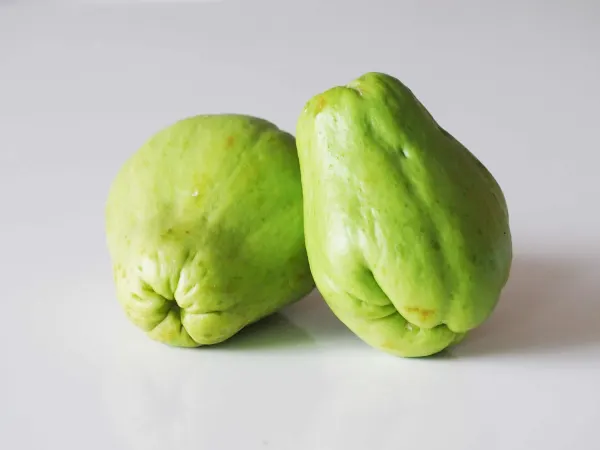Chayote
Fruit
Age Suggestion
6 months
Iron-Rich
No
Common Allergen
No

When can babies eat chayote?
Chayote may be introduced as soon as your baby is ready to start solids, which is generally around 6 months of age.
Background and origins of chayote
Chayote is a crisp, juicy squash with cream- or green-colored rind and bright white flesh that tastes herbal and mildly sweet. It is a key ingredient in cooking all over the world, where it is eaten raw and cooked like squash in both sweet and savory dishes, from cakes to casseroles to chow chow to curries. When eaten raw, chayote has crunch like an apple and refreshing texture like cucumber—the chayote’s distant cousin in the squash family.
Like most gourds, the plant originated in Central America, where Spanish colonizers adopted the Nahuatl word chayohtli for the squash, which were capable of lasting in storage during long journeys at sea. Its hardiness may be how chayote proliferated in the American South, according to food historian Lance Hill, who has studied the impact of the Haitian Revolution on the squash’s journey from its native lands to the Caribbean islands to the Louisiana, where it is called mirliton. Today, chayote grows in abundance on prolific climbing vines in tropical regions around the world, where the squash is known as choko, chou chou, christophene, labu siam, perulero, and vegetable pear, among other names.
Note that all parts of the chayote plant are edible, including the flowers, leaves, and starchy roots, but this page is all about the squash, which can be offered in both sweet and savory dishes. Check out nutrition information and serving suggestions!
Videos
Is chayote healthy for babies?
Yes. Chayote contains plenty of zinc for robust metabolism, folate for neurological development, vitamin B6 for brain development, and vitamin C for healthy skin and immunity. It also offers trace amounts of fiber, vitamin A, calcium, copper, and iron—essential nutrients to help your baby thrive.
Like other members of the squash family, chayote contains powerful antioxidants, which may reduce inflammation, regulate blood-sugar levels, and metabolize fat. The plant has a long history of use in folk medicine, including in its native home of Central America, where Indigenous people used the cooked fruit and young leaves to treat urinary tract infections and to help dissolve kidney stones.
★ Tip: When shopping for chayote, look for squash that is firm with no bruises or dark spots. The squash should feel compact, but not rock hard—like a pear that has started to ripen.
Is chayote a common choking hazard for babies?
Yes. Raw chayote is a choking hazard if it is not cut and cooked in a way that is safe for your child to consume. Well-cooked chayote should not be a common choking hazard when prepared and served according to your child's eating development. As always, be sure to create a safe eating environment and always stay near your baby during mealtime. Check out our age-appropriate serving suggestions!
For more information, visit our section on gagging and choking and familiarize yourself with common choking hazards.
Is chayote a common allergen?
No. Allergies to chayote are rare, though it’s not uncommon to get an itchy rash on the hands after handling vegetables in the squash family, especially when raw. When peeled, chayote secretes a milky substance that can irritate the skin. To minimize any reaction, wear gloves or run the chayote under cool water while peeling. This substance does not generally cause any issue after cooking the chayote, so the risk of reaction while eating is low. Consider applying a barrier ointment, such as pure white petroleum jelly, around baby’s mouth before eating, and wash your baby’s face and hands after eating.
As you would when introducing any new food, start by offering a small quantity on its own for the first few of servings. If there is no adverse reaction, gradually increase the quantity over future meals.
How do you prepare chayote for babies with baby-led weaning?
Every baby develops on their own timeline, and the suggestions on how to cut or prepare particular foods are generalizations for a broad audience.
6 to 9 months old:
Offer well-cooked, mashed chayote for baby to eat with their hands or from a pre-loaded spoon or serve large sections of cooked chayote for baby to munch on as a finger food. If a too-big piece of chayote breaks off in your baby’s mouth, stay calm and give your baby a chance to work the food forward independently before intervening.
9 to 18 months old:
At this age, your baby is developing a pincer grasp (where the thumb and pointer finger meet), which makes it easier to pick up smaller pieces of food. Try offering bite-sized pieces of well-cooked chayote or continue to offer large sections or slices of well-cooked chayote or mash and serve on a pre-loaded utensil. If you’d like to serve raw chayote, you can, just slice thinly (or grate) to reduce the choking risk as raw chayote can be quite challenging to chew.
18 to 24 months old:
Fork time! Offer bite-sized pieces of cooked chayote along with a fork to encourage utensil practice. Help show how it is used by pre-loading the fork for your baby to pick up independently or try spearing the chayote while making a sound (boink!) to make it fun to use the utensil. To serve chayote raw, continue to serve in thin slices, increasing the thickness as your toddler’s eating skills advance. As always, make sure your child is seated in a supported position when eating (and not running around) and that you are an arm’s length away at mealtime.
Chayote rind is edible, but if it’s too thick, go ahead and peel it. Like other squash, chayote secretes a sticky sap that is harmless but can cause a rash. While peeling, wear gloves or hold it under running water to minimize the impact.
For more information on how to cut food for babies, visit our page on Food Sizes & Shapes.
Written by
Expert Tips Delivered to Your Inbox
Sign up for weekly tips, recipes and more!
The content offered on SolidStarts.com is for informational purposes only. Solidstarts is not engaged in rendering professional advice, whether medical or otherwise, to individual users or their children or families. No content on this site, regardless of date, should ever be used as a substitute for direct medical advice from your doctor or your medical or health professional, nutritionist, or expert in pediatric feeding and eating. By accessing the content on SolidStarts.com, you acknowledge and agree that you are accepting the responsibility for your child’s health and well-being. In return for providing you with an array of content “baby-led weaning” information, you waive any claims that you or your child may have as a result of utilizing the content on SolidStarts.com.












